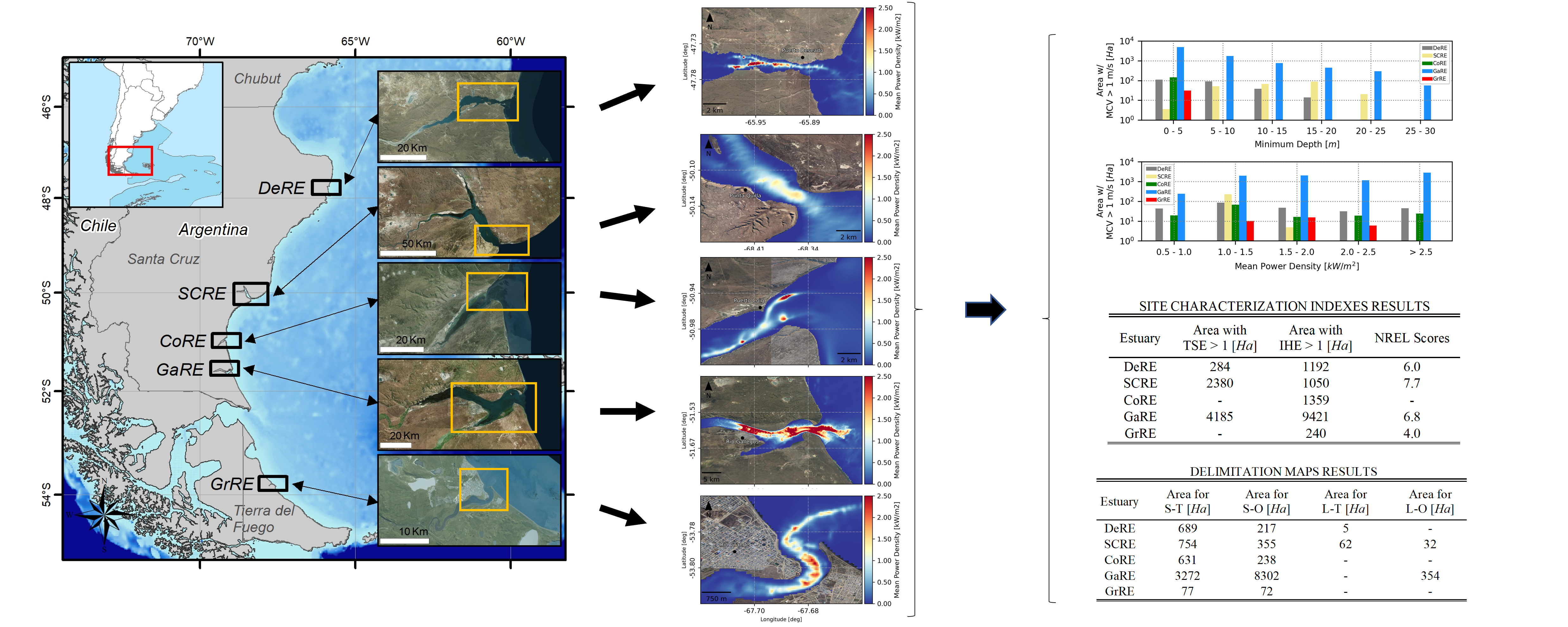Hydrokinetic energy potential in Argentine estuaries with high tidal ranges
Keywords:
Tidal streams, Resource assessment, Patagonian estuaries, Potential energy, Numerical ModellingAbstract
Advancing in the resource assessment for the tidal stream energy harnessing is essential to have a predictable energy source. On the Patagonian coast of Argentina, there are tidal conditions with high ranges that favors the implementation of projects of this type. Specifically, there are five estuaries in which the proximity to points of energy demand transforms them into sites of interest. In this work, in these estuaries and using numerical modelling, an analysis of the hydrodynamic and energetic variables (available minimum depths, mean current velocities and potential energy) was developed, integrated with site selection indicators. The modelling strategy was based on a system of nested models to achieve greater discretization inside the estuaries (approximately 100 m and 15 s). Models were calibrated based on tidal predictions in estuarine ports due to the lack of systematic measurements. The results indicated the presence of wide areas with energy potential greater than 1.5 KW/m2 and a diversity of depths and velocities that would allow the use of different scales of energy converters.
Downloads
References
A. W. Archer, “World's highest tides: Hypertidal coastal systems in North America, South America and Europe”, Sedimentary Geology, vol. 284–285, pp. 1-25, Feb 2013. DOI: 10.1016/J.SEDGEO.2012.12.007
N. D. Badano, R. Espina Valdés, E. Álvarez Álvarez, “Tidal current energy potential of Nalón river estuary assessment using a high precision flow model”, Open Eng., vol 8, pp. 118–123, May 2018. https://doi.org/10.1515/eng-2018-0015.
A. S. Bahaj, A. F. Mollando, J. R. Chaplin, W. M. J. Batten, “Power and thrust measurements of marine current turbines under various hydrodynamic flow conditions in a cavitation tunnel and a towing tank”, Renewable Energy, vol 32, no. 3, pp. 407-426, March 2007.
https://doi.org/10.1016/j.renene.2006.01.012
L. Bindelli, L. D. Kazimierski, M. Re, “Evaluación del potencial energético de las corrientes de marea en estuarios patagónicos mediante modelación numérica. Informe II – Modelos numéricos y potencial energético”, National Institute for Water, Buenos Aires, Argentina, 2020.
M. S. Chowdhury et al. “Current trends and prospects of tidal energy technology”, Environ Dev Sustain, vol. 23, pp. 8179–8194, June 2021. https://doi.org/10.1007/s10668-020-01013-4
M. G. Dinápoli, J. J. Ruiz, C. G. Simionato, G. Berden, “Improving the short-range forecast of storm surges in the Southern-West Atlantic Continental Shelf using 4DEnSRF data assimilation”, Quarterly Journal of the Royal Met. Soc., to be published.
D.M. Fouz, R. Carballo, I. López, G. Iglesias, “Tidal Stream Energy potential in the Shannon Estuary”, Renewable Energy, vol. 185, pp. 61-74, Feb. 2022.
F. Haspert (2018). Delimitación de la zona intermareal de cinco estuarios patagónicos mediante el uso de imágenes satelitales. Presented at IFRH - 4th. Meeting of Young Researchers in Water Resources, Ezeiza, Argentina.
C. Hill, M. Musa, M. Guala, “Interaction between axial flow hydrokinetic tubrines and uni-directional flow bedforms”, Renewable Energy, vol. 86, pp. 409-421, Feb. 2016.
I. Iglesias, A. Bio, L. Bastos, P. Avilez-Valente, “Estuarine hydrodynamic patterns and hydrokinetic energy production: The Douro estuary case study”, Energy, vol. 222, 119972, May 2021.
A. S. Iyer, et al., “Variability and phasing of tidal current energy around the United Kingdom”, Renewable Energy, vol. 51, pp. 343–357, March 2013.
D. Kumar, S. Sarkar, “A review on the technology, performance, design optimization, reliability, techno-economics and environmental impacts of hydrokinetic energy conversion systems”, Renewable and Sustainable Energy Reviews, vol. 58, pp. 796-813, May 2016.
F. H. Lyard, et al., “FES2014 global ocean tide atlas: design and performance”, Ocean Sci., vol. 17, no. 3, pp. 615–649, May 2021. https://doi.org/10.5194/os-17-615-2021.
A. Mohammadian, B. Morse, J. L. Robert, “Assessment of Tidal Stream Energy resources in a hypertidal estuary with highly irregular bathymetry using 3D numerical modelling”, J. Ocean Eng. Mar. Energy, vol. 5, pp. 267–281, July 2019. https://doi.org/10.1007/s40722-019-00138-7
C. M. Niebuhr, et al., “A review of hydrokinetic turbines and enhancement techniques for canal installations: Technology, applicability and potential”, Ren. and Sust. Energy Reviews, vol. 113, 109240, Oct. 2019.
M. C. Piccolo and G. M. E. Perillo, “Estuaries of Argentina: A review” in Estuaries of South America: Their geomorphology and dynamics, ed. G.M.E. Perillo, M.C. Piccolo, and M. Pino Quivira, Berlin: Springer, 1999, ch. 6, pp. 101–132.
S. Walker, P.R. Thies, “A review of component and system reliability in tidal turbine deployments”, Ren. and Sust. Energy Reviews, vol. 151, 111495, Nov. 2021.
T. Wang, Z. A. Yang, “Tidal Hydrodynamic Model for Cook Inlet, Alaska, to Support Tidal Energy Resource Characterization”, J. Mar. Sci. Eng., vol. 8, no. 4, 254, April 2020. https://doi.org/10.3390/jmse8040254.
P. Weatherall, et al., “A new digital bathymetric model of the world's oceans”, Earth and Space Science, vol. 2, no. 8, pp. 331–345, Aug. 2015. doi:10.1002/2015EA000107.
I. M. Yuce, A. Muratoglu, “Hydrokinetic energy conversion systems: A technology status review”, Ren. and Sust. Energy Reviews, vol. 43, pp. 72-82, March 2015.


